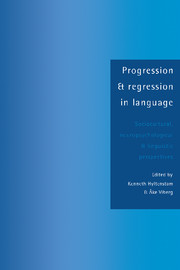 Progression and Regression in Language
Progression and Regression in Language Book contents
- Frontmatter
- Contents
- List of contributors
- Preface
- INTRODUCTION
- THE SOCIOCULTURAL SETTING
- PSYCHO- AND NEUROLINGUISTIC ASPECTS
- 6 Neurolinguistic aspects of first language acquisition and loss
- 7 Neurolinguistic aspects of second language development and attrition
- 8 Second language acquisition as a function of age: research findings and methodological issues
- 9 Second language regression in Alzheimer's dementia
- THE LINGUISTIC PERSPECTIVE 1: DISCOURSE, GRAMMAR, AND LEXIS
- THE LINGUISTIC PERSPECTIVE 2: PHONOLOGY
- Index
7 - Neurolinguistic aspects of second language development and attrition
Published online by Cambridge University Press: 06 July 2010
- Frontmatter
- Contents
- List of contributors
- Preface
- INTRODUCTION
- THE SOCIOCULTURAL SETTING
- PSYCHO- AND NEUROLINGUISTIC ASPECTS
- 6 Neurolinguistic aspects of first language acquisition and loss
- 7 Neurolinguistic aspects of second language development and attrition
- 8 Second language acquisition as a function of age: research findings and methodological issues
- 9 Second language regression in Alzheimer's dementia
- THE LINGUISTIC PERSPECTIVE 1: DISCOURSE, GRAMMAR, AND LEXIS
- THE LINGUISTIC PERSPECTIVE 2: PHONOLOGY
- Index
Summary
INTRODUCTION
Neurolinguistics itself is a relatively young discipline, with no single overarching theory, and no governing paradigm guiding our study of the ways in which language is organized and processed in the brain. With respect to the neurolinguistics of second languge organization and processing, then, our knowledge must necessarily be limited. However there are pockets of accepted knowledge in neurolinguistics generally, and a sizeable number of accepted techniques that have yielded this knowledge. This paper is structured to discuss, first, that knowledge we appear to have concerning the neurolinguistics of second language acquisition and processing, and second, the phenomena of second language acquisition and processing that should eventually be accountable for by neurolinguistic techniques. It will be seen that, even in the areas where we have some knowledge, there is still a certain degree of controversy.
EXISTING KNOWLEDGE
Lateral dominance for language in the bilingual or second language Learner
While knowledge of lateral dominance in monolinguals appears settled (left hemisphere dominance for language in 98% of right handers; about an equal split between left dominance, right dominance, and bilateral organization among left handers) the knowledge about lateral organization in second language acquirers and bilinguals remains disputed. One set of findings has purported to show no difference in lateral organization, either between monolinguals and bilinguals, for L2, or for each of the two languages of the bilingual. The more compelling evidence, by my analysis, comes from the literature which demonstrates greater right hemisphere involvement, particularly in the earlier stages of second language acquisition, than in monolinguals of an equivalent age.
- Type
- Chapter
- Information
- Progression and Regression in LanguageSociocultural, Neuropsychological and Linguistic Perspectives, pp. 178 - 195Publisher: Cambridge University PressPrint publication year: 1994
